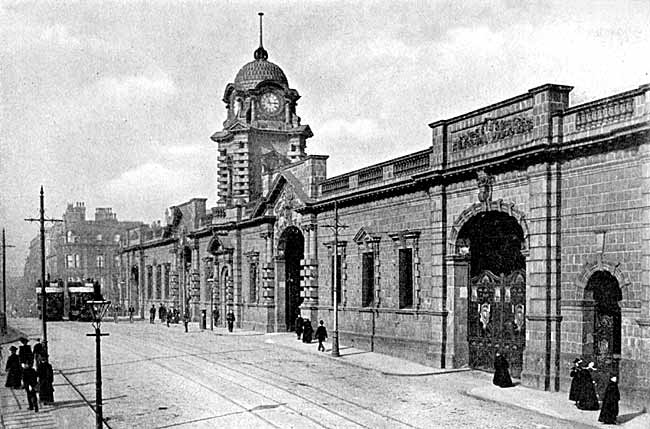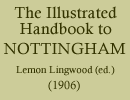< Previous | Contents | Next >
CHAPTER I.
To Nottingham by rail and road.
The City of Nottingham.
THE City of Nottingham is situated near the middle of the Map of England, in the southern part of the county of the same name. No place in the United Kingdom is better provided with Railway Communication. Several of the great companies have stations here, and we will assume for the moment the visitor for whom this little book is intended arrives in Nottingham by one of these routes.
The Midland Railway passes through Nottingham on its way to Carlisle and Scotland. The 123 miles from London can be covered in 2 hours 12 minutes in a "non-stop" run, but frequently short stays are made at Bedford, Kettering, or Leicester. Approaching Nottingham, the train passes through the suburb of West Bridgford, and immediately afterwards dashes across the River Trent, which forms the boundary between the plebeian "Town" and the aristocratic "County." Five bridges cross the river in this immediate neighbourhood. The first carries the railway as just mentioned; the second, a few hundred yards higher up supports the high road to Loughborough, Leicester, and London; the new handsome suspension bridge is for foot passengers between the Victoria Embankment and West Bridgford, and also conveys the water mains; above the bend the river is crossed by the Great Central Railway; and, finally, there is the toll-bridge and roadway to the picturesque villages of Wilford and Clifton. But not much is seen from the Midland Line between the river and the handsome new station. If it be Wednesday, the Cattle Market on the left hand presents a scene of busy animation. It may chance, also, that a game of County Cricket or Football is in progress on the famous Trent Bridge ground, but this must be looked for just before the river is crossed.
The main line from the NORTH leaves the Valley of the Erewash at Trowell, and reaches that of the Leen at Radford (rivers of well-known local celebrity). Thence skirting the borough, we get a flying glimpse of the suburb of Lenton and the residential quarter known as the "Park," of the noble Castle Rock with its time-worn edifice on the summit, linking the present with the distant past as we hasten on toward that very modern institution, the railway station. The line from Derby and the WEST OF ENGLAND joins the one just mentioned in the meadows below the Park, while that from Lincoln and Newark, running parallel with the Great Northern after both have passed Colwick, skirts the Colwick Park Race Course — Colwick Woods being on the right—and reaches the station in company with the London Line.
From MANCHESTER and LIVERPOOL, the traveller passes through some of the most picturesque railway scenery in England, viz., the beautiful Derbyshire valleys of the Wye and Derwent. At Ambergate Junction the run to Nottingham is completed either via Pye Bridge and the Erewash Valley, or by keeping the train as far as Derby, and there changing.
The Great Central Main Line FROM LONDON to Manchester passes through Nottingham, and has communication with London and the South, with the great Lancashire towns, or with Scotland, via York. By means of this Company's connections with other railways, passengers for Nottingham can travel from the South and West of England without changing carriage. The Lancashire, Derbyshire, and East Coast Line, known as the "Dukeries Railway," has just been purchased (1905) by the Great Central. The Main Line from the South, after passing Leicester and Loughborough, approaches the neighbourhood of Nottingham at East Leake and Ruddington, both of which are becoming holiday resorts for the townsfolk. The ancient village of Wilford is next seen on the left, and the Trent is crossed close to Wilford Bridge. With the suddenness of magic the scene changes from a rural to an urban one, and the train plunges into the densely populated district of the MEADOWS—long deprived of crocuses, for which it used to be famous, although "Crocus Street" remains. The Midland Station is crossed by means of a handsome viaduct, and our route continues on a level with the tops of the houses—some of the most squalid in the whole city—until a junction is effected with the Great Northern line, coining in from the south-east. After passing through a short tunnel, the Victoria (Joint) Station is reached.
Approaching from the NORTH, the Great Central Line enters the City boundary at Bulwell, then come the suburban stations of Bulwell Common (for Golf Links), Haydn Road, and Carrington. The last mile and a half of the journey is through a tunnel, except for a few yards at Carrington Station. The cheerful expanse of the Victoria Station is a welcome change after so long a spell underground.
The Great Northern Railway.
Passengers for Nottingham change at Grantham, coming from the South, and at Newark coming from the North. The branch lines from these towns unite at Bottesford, where the graceful church spire should be noted, and Belvoir Castle, the seat of the Duke of Rutland crowning the hills on the left.
Nearer Nottingham, we pass Radcliffe-on-Trent, a favourite holiday resort for the townspeople; and Netherfield, a rather uninteresting overgrown village, created by a large influx of railway-men. The line passes below the suburb of Sneinton, occupying the hill on the right, then the London Road Station, and climbs on a series of arches of gradual ascent to the Victoria Station. This Company possesses running powers over the Great Central, north of Nottingham as far as Manchester, but its own line, except for short branches to Pinxton and Shirebrook, turns west at Kimberley and ultimately reaches Derby, Burton, and Stafford.
The London & North Western Railway offers facilities for visitors coming from Northampton and certain other stations on that Company's lines. The Nottingham terminus is the old Great Northern Station, which was practically vacated when the Victoria Station was opened (1900) for the joint use of the Great Northern and Great Central Companies.
Railway Stations.
This is a convenient place to say something about our Nottingham Railway Stations, although the tired traveller on arrival may not feel inclined for a detailed description.
The handsome Midland Station involved, in its construction, several engineering difficulties which had to be overcome. First the lines of rails had to undergo widening for several hundred yards, an extension which necessitated the demolition of one side of Queen's Road. Then the Carrington Street Bridge had to be considerably lengthened to carry the street over the railway, and widened by the erection of several new substantial piers, for the purpose of sustaining the new Booking Hall. This is now entered from the bridge, by means of several handsome wrought-iron gates. The hall itself is built of terra-cotta blocks, forming a Renaissance design, with clock tower and cupola in the centre. The spacious interior is lined by cream-coloured tiles, with olive-green tiled dado. The platforms are reached by short staircases. There are two principal platforms of great length. The refreshment and waiting rooms are of red brick, which, with the glazed roofing, is arranged to form an effective design. Traffic was carried on the whole time occupied by the reconstruction of this Station, which was completed in 1894.

Midland Railway station.
The Victoria Station is a fine building, with lofty clock tower, fronting Mansfield Road, almost opposite Shakespeare Street. Like the new Midland Station, this structure was designed by Mr. A. E. Lambert. Nottingham is exceptionally fortunate in possessing two such elegant stations of modern design, built by the same hand within a few years of each other. The Victoria Station, which was opened in 1900, is used by the Great Central and Great Northern Railways. The Great Northern Company formerly occupied the London Road Low Level Station, now used by the London and North Western. To reach the Victoria Station a new line was constructed from a point east of the old station to join the Great Central just before it disappears in the tunnel at Weekday Cross. This improvement involved the destruction of the picturesque Sneinton Hermitage.
The main entrances from the street lead into a spacious Booking Hall, with ticket windows for both companies. The platforms, being at a lower level, are reached by an iron bridge and staircases. The waiting and other rooms on the platforms are convenient and comfortable, and being built of brown and white glazed brick, present a light and effective appearance.
The London and North Western Station is in Station Street, a thoroughfare running alongside the Midland Station. This is smaller than the two first described, and being some fifty years old, cannot be said to be up-to-date. Opposite stands the new London Road High Level Station, belonging to the Great Northern. It is used by passengers for this part of the town and by others changing carriages. These railway stations and the Midland are connected with the town by a frequent tram service. So also indeed is the Victoria, but the distance between it and the Market Place is only a five minutes' walk.
Approaches to Nottingham by Road
Travelling by road, whether by motor carriage or by bicycle, is now so common that it may be expedient to say a few words on the approaches to Nottingham by road. The visitor who is going North along the centre of England will find an excellent road through St. Albans, Northampton, Leicester, Loughborough, and Nottingham. Nearing the latter town, the pleasant suburb of West Bridgford is passed and Nottingham entered by way of Trent Bridge. Thence the route lies along busy Arkwright Street, past the new Midland Railway Station, Carrington Street, to the Market Place. From Leeds and places farther north, Nottingham may be reached by way of Chesterfield and Mansfield. By this route the Corporation Tramways are first encountered at Sherwood. If the trams be followed tqwnwards, we come successively to Carrington, the Forest Recreation Ground, and St. Andrew's Church, the Church Cemetery being on the right. Descending the hill, we pass the Victoria Station, and turning the corner at Parliament Street, speedily find ourselves in the Market Place. Travellers along that most popular route, the Great North Road, can visit Nottingham by deviating to the west for about twenty miles. Journeying from the South, the North Road is left at Grantham, whence there is good riding through Bottesford, Bingham, and Radcliffe-on-Trent. At West Bridgford this route falls into the Loughborough Road, above-mentioned. Coming from the North, the main road is left at Newark and the journey continued on the ancient Fosseway (Roman Road) which, west of Bingham, falls into the last-mentioned route.
The routes from the North-West and West meet at Derby, whence a good road runs into Nottingham by way of Draycott and Risley. Nearer Nottingham, Stapleford and Bramcote are passed. At Lenton is seen the castellated entrance to Wollaton Park, the seat of Lord Middleton. After the railway has been crossed, the road commences a steep rise, known as Lenton Sands, and, after the crest has been reached, descends the commercial thoroughfare of Derby Road, which speedily brings us to the centre of the town. The direct road from BRISTOL and the SOUTH-WEST takes us through Gloucester, Worcester, Birmingham, Ashby-de-la-Zouch, and the ancient little town of Castle-Donington. Continuing by way of the manufacturing villages of Long Eaton and Beeston, the road falls into the last mentioned about three miles from Nottingham.
From Lincoln and North Lincolnshire the road lies through Newark. From Boston, Skegness, and the popular South Lincolnshire watering-places we must make for Grantham.
